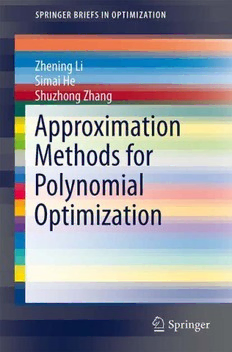
Approximation Methods for Polynomial Optimization: Models, Algorithms, and Applications PDF
Preview Approximation Methods for Polynomial Optimization: Models, Algorithms, and Applications
SpringerBriefs in Optimization SeriesEditors PanosM.Pardalos Ja´nosD.Pinte´r StephenM.Robinson Tama´sTerlaky MyT.Thai SpringerBriefs in Optimization showcases algorithmic and theoretical tech- niques,casestudies,andapplicationswithinthebroad-basedfieldofoptimization. Manuscripts related to the ever-growing applications of optimization in applied mathematics, engineering, medicine, economics, and other applied sciences are encouraged. Forfurthervolumes: http://www.springer.com/series/8918 Zhening Li (cid:129) Simai He (cid:129) Shuzhong Zhang Approximation Methods for Polynomial Optimization Models, Algorithms, and Applications 123 ZheningLi SimaiHe DepartmentofMathematics DepartmentofManagementSciences ShanghaiUniversity CityUniversityofHongKong Shanghai KowloonTong China HongKong ShuzhongZhang IndustrialandSystemsEngineering UniversityofMinnesota Minneapolis,MN USA ISSN2190-8354 ISSN2191-575X(electronic) ISBN978-1-4614-3983-7 ISBN978-1-4614-3984-4(eBook) DOI10.1007/978-1-4614-3984-4 SpringerNewYorkHeidelbergDordrechtLondon LibraryofCongressControlNumber:2012936832 Mathematics Subject Classification (2010): 90C59, 68W25, 65Y20, 15A69, 15A72, 90C26, 68W20, 90C10,90C11 ©ZheningLi,SimaiHe,ShuzhongZhang2012 Thisworkissubjecttocopyright.AllrightsarereservedbythePublisher,whetherthewholeorpartof thematerialisconcerned,specificallytherightsoftranslation,reprinting,reuseofillustrations,recitation, broadcasting,reproductiononmicrofilmsorinanyotherphysicalway,andtransmissionorinformation storageandretrieval,electronicadaptation,computersoftware,orbysimilarordissimilarmethodology nowknownorhereafterdeveloped.Exemptedfromthislegalreservationarebriefexcerptsinconnection with reviews or scholarly analysis or material supplied specifically for the purpose of being entered and executed on a computer system, for exclusive use by the purchaser of the work. Duplication of this publication or parts thereof is permitted only under the provisions of the Copyright Law of the Publisher’slocation,initscurrentversion,andpermissionforusemustalwaysbeobtainedfromSpringer. PermissionsforusemaybeobtainedthroughRightsLinkattheCopyrightClearanceCenter.Violations areliabletoprosecutionundertherespectiveCopyrightLaw. Theuseofgeneraldescriptivenames,registerednames,trademarks,servicemarks,etc.inthispublication doesnotimply,evenintheabsenceofaspecificstatement,thatsuchnamesareexemptfromtherelevant protectivelawsandregulationsandthereforefreeforgeneraluse. While the advice and information in this book are believed to be true and accurate at the date of publication,neithertheauthorsnortheeditorsnorthepublishercanacceptanylegalresponsibilityfor anyerrorsoromissionsthatmaybemade.Thepublishermakesnowarranty,expressorimplied,with respecttothematerialcontainedherein. Printedonacid-freepaper SpringerispartofSpringerScience+BusinessMedia(www.springer.com) Preface Polynomial optimization, as its name suggests, is used to optimize a generic multivariate polynomial function, subject to some suitable polynomial equality and/orinequalityconstraints.Suchproblemformulationdatesbacktothenineteenth centurywhentherelationshipbetweennonnegativepolynomialsandsumofsquares (SOS)wasdiscussedbyHilbert.Polynomialoptimizationisoneofthefundamental problems in Operations Research and has applications in a wide range of areas, includingbiomedicalengineering,controltheory,graphtheory,investmentscience, materialscience, numericallinearalgebra,quantummechanics,signalprocessing, speech recognition, among many others. This brief discusses some important subclasses of polynomial optimization models arising from various applications. The focus is on optimizing a high degree polynomial function over some fre- quently encountered constraint sets, such as the Euclidean ball, the Euclidean sphere, intersection of co-centered ellipsoids, binary hypercube, general convex compactset, and possibly a combinationof the above constraints. All the models under consideration are NP-hard in general. In particular, this brief presents a study on the design and analysis of polynomial-time approximation algorithms, with guaranteed worst-case performance ratios. We aim at deriving the worst- case performance/approximation ratios that are solely dependent on the problem dimensions, meaning that they are independentof any other types of the problem parametersorinputdata.Thenewtechniquescanbeappliedtosolveevenbroader classes of polynomial/tensor optimization models. Given the wide applicability of the polynomial optimization models, the ability to solve such models—albeit approximately—is clearly beneficial. To illustrate how such benefits might be, we present a variety of examples in this brief so as to showcase the potential applicationsofpolynomialoptimization. Shanghai,China ZheningLi KowloonTong,HongKong SimaiHe Minnesota,MN,USA ShuzhongZhang v Contents 1 Introduction .................................................................. 1 1.1 History................................................................... 1 1.1.1 Applications..................................................... 2 1.1.2 Algorithms...................................................... 6 1.2 Contributions............................................................ 9 1.3 NotationsandModels................................................... 10 1.3.1 ObjectiveFunctions............................................. 10 1.3.2 ConstraintSets.................................................. 12 1.3.3 ModelsandOrganization....................................... 13 1.4 Preliminary.............................................................. 14 1.4.1 TensorOperations .............................................. 15 1.4.2 ApproximationAlgorithms..................................... 17 1.4.3 RandomizedAlgorithms ....................................... 18 1.4.4 SemidefiniteProgrammingRelaxationandRandomization.. 19 2 PolynomialOptimizationOvertheEuclideanBall....................... 23 2.1 MultilinearForm........................................................ 24 2.1.1 ComputationalComplexity..................................... 25 2.1.2 CubicCase...................................................... 26 2.1.3 GeneralFixedDegree .......................................... 29 2.2 HomogeneousForm .................................................... 30 2.2.1 LinkBetweenMultilinearFormandHomogeneous Form............................................................. 31 2.2.2 TheOddDegreeCase .......................................... 32 2.2.3 TheEvenDegreeCase ......................................... 33 2.3 MixedForm ............................................................. 35 2.3.1 ComplexityandaStep-by-StepAdjustment .................. 36 2.3.2 ExtendedLinkBetweenMultilinearFormandMixed Form............................................................. 39 2.4 InhomogeneousPolynomial............................................ 40 2.4.1 Homogenization ................................................ 43 2.4.2 MultilinearFormRelaxation................................... 44 vii viii Contents 2.4.3 AdjustingtheHomogenizingComponents.................... 46 2.4.4 FeasibleSolutionAssembling.................................. 49 3 ExtensionsoftheConstraintSets .......................................... 53 3.1 HypercubeandBinaryHypercube..................................... 53 3.1.1 MultilinearForm................................................ 55 3.1.2 HomogeneousForm............................................ 59 3.1.3 MixedForm..................................................... 62 3.1.4 InhomogeneousPolynomial.................................... 64 3.1.5 Hypercube....................................................... 70 3.2 TheEuclideanSphere................................................... 70 3.3 IntersectionofCo-centeredEllipsoids................................. 74 3.3.1 MultilinearForm................................................ 76 3.3.2 HomogeneousForm............................................ 81 3.3.3 MixedForm..................................................... 83 3.3.4 InhomogeneousPolynomial.................................... 84 3.4 ConvexCompactSet.................................................... 87 3.5 MixtureofBinaryHypercubeandtheEuclideanSphere............. 90 3.5.1 MultilinearForm................................................ 91 3.5.2 HomogeneousForm............................................ 94 3.5.3 MixedForm..................................................... 96 4 Applications .................................................................. 99 4.1 Homogeneous Polynomial Optimization Over theEuclideanSphere.................................................... 99 4.1.1 SingularValuesofTrilinearForms ............................ 99 4.1.2 Rank-OneApproximationofTensors.......................... 100 4.1.3 EigenvaluesandApproximationofTensors................... 101 4.1.4 DensityApproximationinQuantumPhysics.................. 103 4.2 InhomogeneousPolynomialOptimizationOveraGeneralSet....... 104 4.2.1 PortfolioSelectionwithHigherMoments..................... 104 4.2.2 SensorNetworkLocalization .................................. 105 4.3 DiscretePolynomialOptimization..................................... 106 4.3.1 TheCut-NormofTensors...................................... 106 4.3.2 MaximumCompleteSatisfiability............................. 107 4.3.3 Box-ConstrainedDiophantineEquation....................... 108 4.4 MixedIntegerProgramming............................................ 109 4.4.1 MatrixCombinatorialProblem ................................ 109 4.4.2 Vector-ValuedMaximumCut.................................. 110 5 ConcludingRemarks........................................................ 113 References......................................................................... 119 Chapter 1 Introduction Polynomialoptimizationistooptimizeapolynomialfunctionsubjecttopolynomial equalityand/orinequalityconstraints,specifically,thefollowinggenericoptimiza- tionmodel: (PO)min p(xxx) s.t. f(xxx)≤0,i=1,2,...,m , i 1 g (xxx)=0, j=1,2,...,m , j 2 xxx=(x ,x ,...,x )T∈Rn, 1 2 n wherep(xxx), f(xxx)(i=1,2,...,m )andg (xxx)(j=1,2,...,m )aresomemultivariate i 1 j 2 polynomial functions. This problem is a fundamental model in the field of op- timization, and has applications in a wide range of areas. Many algorithms have beenproposedforsubclassesof(PO),andspecializedsoftwarepackageshavebeen developed. 1.1 History The modern history of polynomial optimization may date back to the nineteenth century when the relationship between nonnegative polynomial function and the sumofsquares(SOS)ofpolynomialswasstudied.Givenamultivariatepolynomial function that takes only nonnegative values over the real domain, can it be representedasanSOSofpolynomialfunctions?Hilbert[51]gaveaconcreteanswer in 1888, which asserted that the only cases for a nonnegative polynomial to be a SOSare:univariatepolynomials;multivariatequadraticpolynomials;andbivariate quarticpolynomials.Later,theissueaboutnonnegativepolynomialswasformulated in Hilbert’s17th problem—oneof the famous23 problemsthat Hilbertaddressed in his celebrated speech in 1900 at the Paris conference of the International Congress of Mathematicians. Hilbert conjectured that a nonnegative polynomial entailsexpressionofdefiniterationalfunctionsasquotientsoftwosumsofsquares. Z.Lietal.,ApproximationMethodsforPolynomialOptimization:Models,Algorithms, 1 andApplications,SpringerBriefsinOptimization,DOI10.1007/978-1-4614-3984-4 1, ©ZheningLi,SimaiHe,ShuzhongZhang2012
